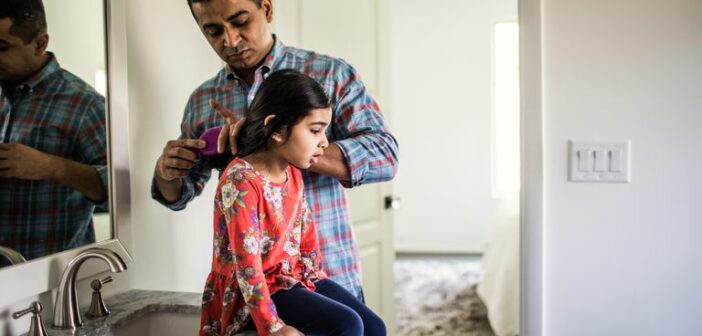Hair loss (alopecia) is a scary and frustrating symptom for parents, especially since you don’t really expect kids to lose their hair. Unfortunately, hair loss is a common symptom, even in kids. In many cases the hair loss is temporary and the child’s hair does grow back.
Common Causes
There are many possible causes of hair loss in children, broadly categorized by infection, physical causes, autoimmune causes, and reactive causes1.
Infections
Ringworm of the scalp (tinea capitis) is one of the more common causes of hair loss2 but is often easy to recognize because of the association scalp findings, including a red circular lesion, hair loss, and a scaly border that may be itchy.
Bacterial infections can cause some hair loss that appears similar to tinea capitis with scaling1. But instead of being caused by ringworm, it is often caused by the Staph aureus bacteria.
Physical Causes
Hair pulling or stroking can be a habit for infants and toddlers, just like thumb sucking, sucking on a pacifier, or rubbing a blanket. It usually stops when kids are around two or three years old, just like thumb sucking, although some continue pulling until they are three to five years old.
Although you can ignore this habit, since it does sometimes cause some hair loss, you could keep your child’s hair cut short or try to move her to one of those other habits if it bothers you.
Trichotillomania is a more worrisome condition thought to be related to obsessive-compulsive disorder (OCD)3. Trichotillomania is defined as a child or teen who compulsively pulls out her hair, feels tension before pulling or when trying to resist pulling, and feels pleasure, gratification, or relief when pulling her hair out.
These children have noticeable hair loss and often need treatment from a child psychiatrist or psychologist who specializes in trichotillomania.
Autoimmune Causes
Alopecia areata is thought to be an autoimmune disorder (the child’s immune’s system attacks the hair follicles) that causes complete hair loss in round or oval patches on a child’s scalp or another body part. There are similar autoimmune conditions, called alopecia totalis and alopecia universalis, in which hair loss is more extensive4.
Alopecia areata is often mistaken for scalp ringworm. Unlike ringworm, alopecia areata causes smooth, round patches on the scalp without any redness or scaling.
Treatments include steroid injections and some topical medications (such as minoxidil, anthralin cream, or high dose steroid creams). Fortunately, hair growth often eventually occurs on its own, too.
Alopecia totalis and alopecia universalis are similar to alopecia areata, except that the child loses all scalp hair (alopecia totalis) or all scalp hair and all body hair (alopecia universalis).
The chances for treatment success and hair regrowth are less for alopecia totalis and alopecia universalis than they are for alopecia areata. A pediatric dermatologist can help treat your child with any of these disorders.
In addition to the treatments already mentioned for alopecia areata, other treatments might include ultraviolet light therapy (PUVA), oral steroids, or oral cyclosporine. A high-quality wig is sometimes the best treatment for alopecia areata and alopecia totalis.
Reactive Causes
One of the classic causes of hair loss in children that many people think about is hair loss associated with childhood cancer. Although this can definitely cause hair loss, it is usually the cancer treatments, such as chemotherapy or radiation (anagen effluvium), that causes hair loss and not cancer itself.
Telogen effluvium is another classic cause of hair loss in children in which surgery, a recent illness (typically with a high fever), sudden weight loss, or emotional stress triggers the spontaneous loss of hair six to 12 weeks later.
Children with telogen effluvium continue to lose hair, often in large clumps for a few weeks or months5, to the point that their hair may be noticeably thin. But then their hair begins to grow again in about six months without any treatments.
It is thought that this hair loss occurs because the original stressor pushes the child’s hair into a resting or dormant phase, instead of its more usual long growth phase. It then falls out until new hair grows and then follows the normal growth phases for hair.
Other Causes
In addition to ringworm, hair pulling, traction alopecia, and the other causes of hair loss mentioned above, other less common causes of hair loss can include:
- Thyroid disorders, including either hypothyroidism and hyperthyroidism
- Illnesses, such as systemic lupus erythematosus, diabetes mellitus, or iron-deficiency anemia
- Malnutrition
- Vitamin A toxicity
You would usually expect your child to have other symptoms besides hair loss if he had any of these disorders. For example, vitamin A toxicity also causes headaches, vision changes, irritability, vomiting, and poor weight gain, etc.
Hair loss can also be caused by structural abnormalities of the hair shaft, which usually results in easy breakage and dry, brittle hair. A pediatric dermatologist can usually identify this kind of abnormality by looking at the hairs under a microscope.




